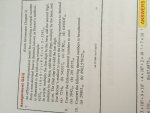solidair1996
New member
- Joined
- Mar 9, 2016
- Messages
- 2
Basically the question is,
An efficient computational model for converting a natural number from a non-decimal base to decimal, known as Horner's method is illustrated in the following example:
6253 (with an increasing power of 8, just right under bottom of number 3) = ( ( 6 x 8 +2 ) x 8 + 5 ) x 8 + 3 = 3243 (with an increasing power of 10, just right under bottom of number 3).
In words multiply the first digit by the base, add the second digit, multiply by the base, add the third digit, multiply by the base , and so on.The final step is to add the last digit.
Use Horner's method to convert the following numbers to decimal.
a) 7216 (with an increasing power of 8, just right under bottom of number 6) (you cant put those symbols on keyboard like the 8 number symbol) answer is: 3726 with a 10 like i said
b) 543517 (with an increasing power of 8, just right under bottom of number 6) (you cant put those symbols on keyboard like the 8 number symbol) answer is : 182095 with a 10 like i said
c) 8CB2 (with an increasing power of 16, just right under bottom of number 2) (you cant put those symbols on keyboard like the 16 number symbol) answer is 36018 with a 10 like i said
D) E490DF (with an increasing power of 16, just right under bottom of number 2) (you cant put those symbols on keyboard like the 16 number symbol) answer is 14979295 with a 10 like i said
PLEASE HELP! show working because i need to understand these problems and the answers do not show how to solve them!
i have attached a image of the question just incase no one understands

An efficient computational model for converting a natural number from a non-decimal base to decimal, known as Horner's method is illustrated in the following example:
6253 (with an increasing power of 8, just right under bottom of number 3) = ( ( 6 x 8 +2 ) x 8 + 5 ) x 8 + 3 = 3243 (with an increasing power of 10, just right under bottom of number 3).
In words multiply the first digit by the base, add the second digit, multiply by the base, add the third digit, multiply by the base , and so on.The final step is to add the last digit.
Use Horner's method to convert the following numbers to decimal.
a) 7216 (with an increasing power of 8, just right under bottom of number 6) (you cant put those symbols on keyboard like the 8 number symbol) answer is: 3726 with a 10 like i said
b) 543517 (with an increasing power of 8, just right under bottom of number 6) (you cant put those symbols on keyboard like the 8 number symbol) answer is : 182095 with a 10 like i said
c) 8CB2 (with an increasing power of 16, just right under bottom of number 2) (you cant put those symbols on keyboard like the 16 number symbol) answer is 36018 with a 10 like i said
D) E490DF (with an increasing power of 16, just right under bottom of number 2) (you cant put those symbols on keyboard like the 16 number symbol) answer is 14979295 with a 10 like i said
PLEASE HELP! show working because i need to understand these problems and the answers do not show how to solve them!
i have attached a image of the question just incase no one understands

